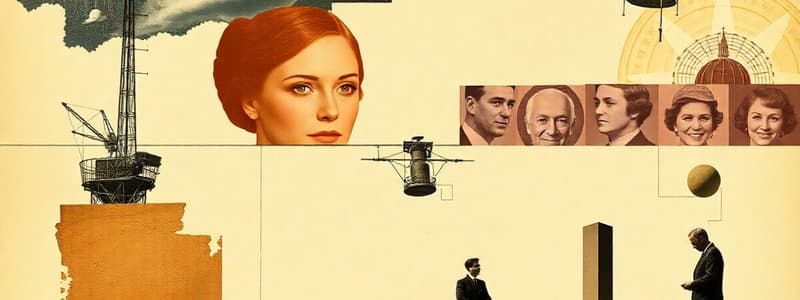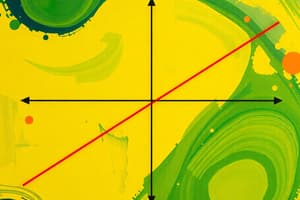Podcast
Questions and Answers
What does the formula $\Delta Q = MPL \times \Delta L + MPK \times \Delta K$ represent?
What does the formula $\Delta Q = MPL \times \Delta L + MPK \times \Delta K$ represent?
- The marginal rate of technical substitution between labor and capital
- The difference in marginal products of labor and capital
- The isoquant shift resulting from an increase in capital only
- Total change in output due to changes in labor and capital (correct)
The Marginal Rate of Technical Substitution (MRTS) is derived from which of the following relationships?
The Marginal Rate of Technical Substitution (MRTS) is derived from which of the following relationships?
- The difference between the total product and marginal product
- The ratio of the marginal products of labor to capital (correct)
- The total output divided by total inputs used
- The change in output relative to the change in labor only
In the context of isoquants, what does a linear isoquant signify?
In the context of isoquants, what does a linear isoquant signify?
- Perfect substitutes with constant substitution rates (correct)
- Diminishing returns from input increases
- Gradual changes in output with varying inputs
- Perfect complements in input usage
What is the mathematical expression for the MRTS in terms of marginal products?
What is the mathematical expression for the MRTS in terms of marginal products?
When total output changes by $\Delta Q = 0$, which condition is implied along the isoquant?
When total output changes by $\Delta Q = 0$, which condition is implied along the isoquant?
How is the slope of an isoquant interpreted in microeconomics?
How is the slope of an isoquant interpreted in microeconomics?
What happens to output if there is a reduction in capital usage while labor is held constant?
What happens to output if there is a reduction in capital usage while labor is held constant?
What does the equation $MRST = - \frac{MP_L}{MP_K}$ indicate?
What does the equation $MRST = - \frac{MP_L}{MP_K}$ indicate?
What happens to long-run average costs as production increases up to a certain point?
What happens to long-run average costs as production increases up to a certain point?
Which factor most commonly leads to economies of scale?
Which factor most commonly leads to economies of scale?
What typically occurs when production output is very high?
What typically occurs when production output is very high?
Which of the following best describes the relationship between output level and average total cost in a typical long-run ATC curve?
Which of the following best describes the relationship between output level and average total cost in a typical long-run ATC curve?
What is a key characteristic of the long-run average total cost (LRATC) curve?
What is a key characteristic of the long-run average total cost (LRATC) curve?
What defines diseconomies of scale?
What defines diseconomies of scale?
What does the term 'multi-product cost function' refer to?
What does the term 'multi-product cost function' refer to?
How does specialization affect worker efficiency in the context of economies of scale?
How does specialization affect worker efficiency in the context of economies of scale?
What does the Marginal Cost (MC) represent in production?
What does the Marginal Cost (MC) represent in production?
Which of the following is included in Farmer Jack's total costs?
Which of the following is included in Farmer Jack's total costs?
What happens to the Marginal Cost as production increases, according to the example provided?
What happens to the Marginal Cost as production increases, according to the example provided?
What would the Total Cost be if Farmer Jack produces 2400 units of wheat?
What would the Total Cost be if Farmer Jack produces 2400 units of wheat?
If the total cost function is denoted as TC(Q), how is Marginal Cost expressed mathematically?
If the total cost function is denoted as TC(Q), how is Marginal Cost expressed mathematically?
In Farmer Jack's cost table, how is the cost of labor affected as he increases production?
In Farmer Jack's cost table, how is the cost of labor affected as he increases production?
What is the Total Cost when Farmer Jack employs 5 workers?
What is the Total Cost when Farmer Jack employs 5 workers?
Which factor contributes to the increase in Marginal Cost as production expands?
Which factor contributes to the increase in Marginal Cost as production expands?
Which total economic cost is incurred by Farmer Jack when producing no units of wheat?
Which total economic cost is incurred by Farmer Jack when producing no units of wheat?
What does the area under the Total Cost curve represent?
What does the area under the Total Cost curve represent?
Which observation can be made about the relationship between Total Cost and output (Q) based on the example?
Which observation can be made about the relationship between Total Cost and output (Q) based on the example?
If Farmer Jack produced 1800 units of wheat, what would be the marginal cost incurred for that interval?
If Farmer Jack produced 1800 units of wheat, what would be the marginal cost incurred for that interval?
Which of the following is a characteristic of the Total Cost curve based on the example provided?
Which of the following is a characteristic of the Total Cost curve based on the example provided?
Flashcards are hidden until you start studying
Study Notes
Cost Functions:
- A firm's cost function is essential for maximizing profit.
- Total cost is defined as the sum of the cost of land and the cost of labor.
- Fixed costs are the costs that remain constant regardless of the level of output (e.g., land).
- Variable costs are the costs that change with the level of output (e.g., labor).
- Labor and capital are assumed to be the only inputs in the examples provided.
Marginal Cost
- Marginal cost (MC) is the increase in total cost from producing one more unit.
- Marginal Cost is a key parameter for determining the optimal level of production in determining profit maximization.
- Marginal Cost can be expressed as the change in total cost divided by the change in quantity (MC= ∆TC/ ∆Q).
- Alternatively, marginal cost can be expressed as the derivative of the total cost function (MC= dTC/dQ).
Isoquants
- An isoquant is a curve that shows all the combinations of labor and capital that can produce a given level of output.
- The slope of an isoquant is the marginal rate of technical substitution (MRTS).
- The MRTS represents the amount of one input that must be substituted for one unit of another input to maintain the same level of output.
- The MRTS is useful to determine the most efficient combination of inputs to produce a given level of output, taking into account the costs of each input.
Long Run Average Costs
- Long-run average cost (LRAC) is the average cost of production when all inputs are variable.
- Short-run average cost (SRAC) is the average cost of production when at least one input is fixed.
- The LRAC curve represents the most efficient scale of production for a given level of output.
- Economies of scale occur when the LRAC decreases as output increases.
- Diseconomies of scale occur when the LRAC increases as output increases.
- Economies of scale occur when increasing production allows for greater specialization of labor and capital.
- Diseconomies of scale often occur due to coordination problems in large organizations.
Jointly Produced Goods
- A multi-product cost function defines the cost of producing multiple outputs jointly.
- Multi-product cost functions are more complex than single-product cost functions.
Studying That Suits You
Use AI to generate personalized quizzes and flashcards to suit your learning preferences.




